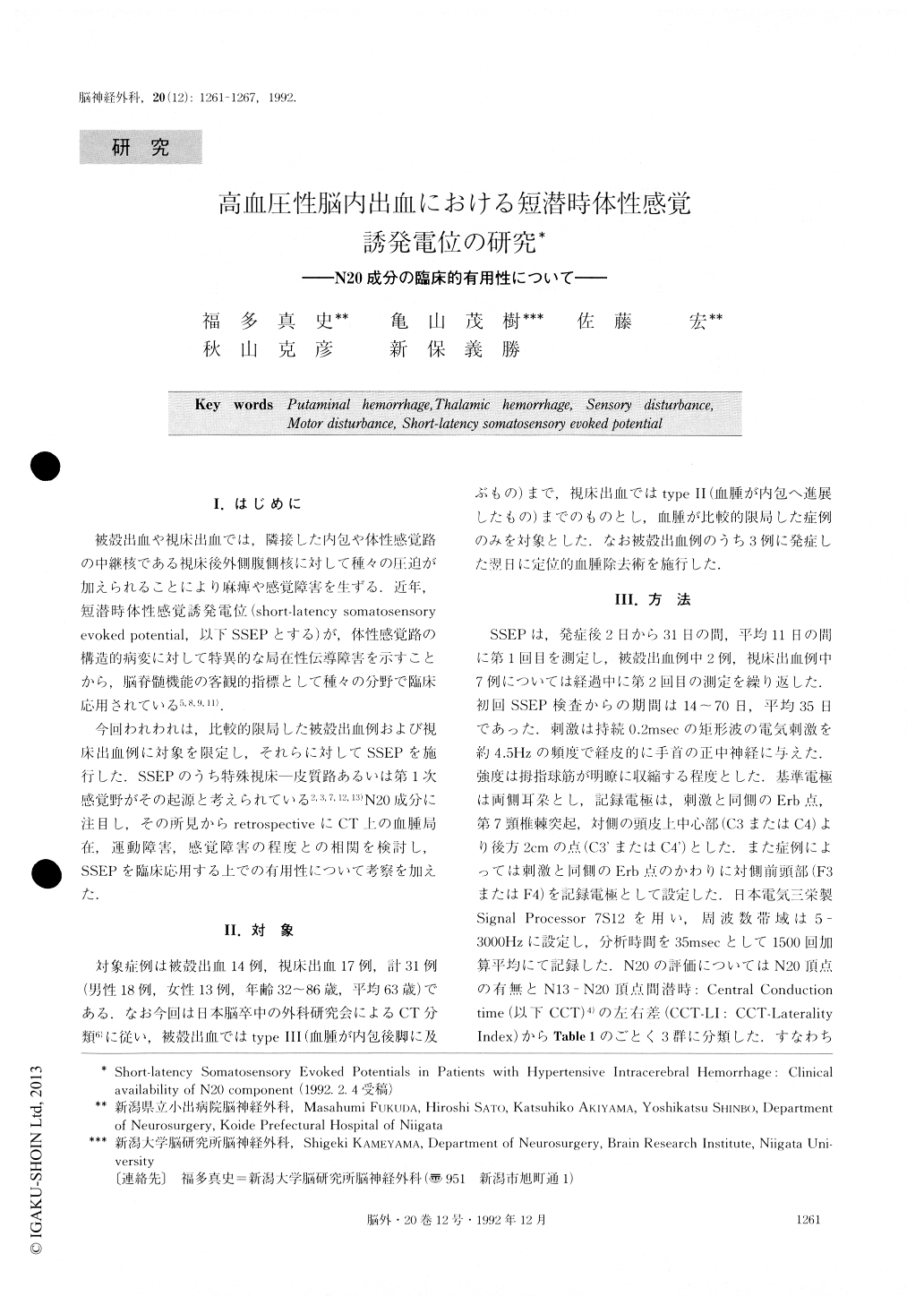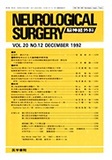Japanese
English
- 有料閲覧
- Abstract 文献概要
- 1ページ目 Look Inside
I.はじめに
被殻出血や視床出血では,隣接した内包や体性感覚路の中継核である視床後外側腹側核に対して種々の圧迫が加えられることにより麻輝や感覚障害を生ずる.近年,短潜時体性感覚誘発電位(short-latency somatosensoryevoked potential,以下SSEPとする)が,体性感覚路の構造的病変に対して特異的な局在性伝導障害を示すことから,脳脊髄機能の客観的指標として種々の分野で臨床応用されている5,8,9,11).
今回われわれは,比較的限局した被殻出血例および視床出血例に対象を限定し,それらに対してSSEPを施行した.SSEPのうち特殊視床一皮質路あるいは第1次感覚野がその起源と考えられている2,3,7,12,13)N20成分に注目し,その所見からretrospectiveにCT上の血腫局在,運動障害,感覚障害の程度との相関を検討し,SSEPを臨床応用する上での有用性について考察を加えた.
Short,latency Somatosensory Evoked Potentials(SSEPs) were studied in 14 patients with putaminalhemorrhage and 17 patients with thalamic hemorrhage.After median nerve stimulation SSEPs were recordedfrom the electrodes placed on C3', C4'(2cm behind C30r C4 of the internal 10-20 system respectively), andCv7.(Reference was the linked ears.) Erb's potentialwas also recorded from the Erb's point using the con-tralateral one as the reference. The patients were classi-fied into three groups according to central conductiontime laterality index(CCT LI). CCT LI=(CCT on theaffected side which is defined as the interpeak iatencybetween N13 and N20)—(CCT on the non affectedside)。 Group 1:CCT LI≦0.73(it means within normallimit);Group 2:CCT LI>0.73(it means the signifi-cant latency delay of the N200n the affected side);Group 3:CCT LI is not available(because the N20was abolished on the affected side). We analyzed re,trospectively the locahzation of the hematoma on CTscans, the degree of motor and sensory disturt)ance ofthe upPer extremity in each group.
Of the 14 patients with putaminal hemorrhage,5were in group 1;3were in group 2;6were in group3,Patients in group l had a localized hematoma withinthe pallido-putamen complex. Patients in groul)2had ahematoma compressing the posterior limb of the inter.nal capsule, Patiellts in group 3 had a hematoma in-volving the posterior limb of the intemal capsule and hadseverer motor disturbance than those in group 1 orgroup 2. Of the 17 patients with thalamic hemorrhage,2were in group 1; 5were in group 2; 10 were ingroup 3. Patients in group l had a hematoma of theanterior thalamus, Patients in group 2 had a hematomacompressing the posterior limb of the internal capsule.Most of the patients in group 3 had a hematoma involv-ing the ventroposterolateral nucleus of the thalarrlusand had severer sensory disturbance than those ingroup l or group 2. We, therefore, conclude that SSEPwas available for clinical use to evaluate the prognos isof motor function of the upper limb in Patients withputaminal hemorrhage. It can also be used to evaluatethe sensory function of patients, with thalamic hemor-rhage.

Copyright © 1992, Igaku-Shoin Ltd. All rights reserved.


